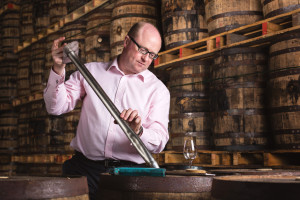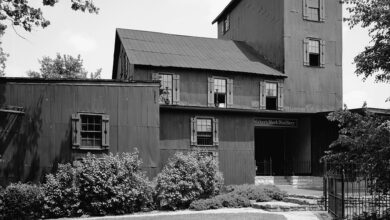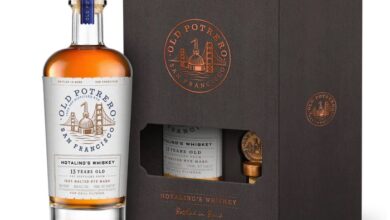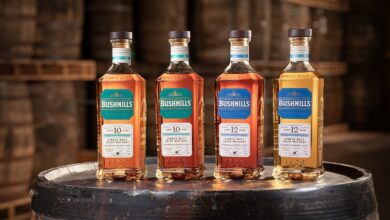Q&A With New Midleton’s Kevin O’Gorman
A Conversation With Jameson’s Master of Maturation
By Richard Thomas

New Midleton’s Master of Maturation
(Credit: Pernod Ricard)
Jameson likes to present the production of their whiskey as a team effort, and while the roles of their Master Distiller and Master Blender should be familiar to even casual whiskey enthusiasts, what the other members of that team might be less so. That last point is especially odd when one considers that, depending on the whiskey in question, 40 to 70% of what a whiskey tastes like depends on in what, where, and for how long it is aged.
Saying maturation is important is an understatement, but what exactly a guy who deals with wood and warehouses at the distillery does is not well understood among whiskey fans. For that reason, I was very happy to become better acquainted with Jameson’s Master of Maturation, Kevin O’Gorman.
RT: Master of Maturation is a job title many American whiskey geeks might be unfamiliar with, where the focus is on running the still and not so much on minding the barrels in the warehouse. Could you describe the basics of what you do at Midleton?
KO: As you know, we place a serious emphasis on the maturation and wood policies at Midleton distillery. My role as Master of Maturation involves many different functions and activities but the overriding principle of having a world class wood management program is top of my list. This involves the selection and procurement of the best wood, the careful management of these casks during filling and dumping and finally, the monitoring and minding of all these casks in warehouse.
Without trying to produce a job description, here are some of my key duties and responsibilities:
- Procurement of all different types of casks from American Bourbon barrels, Sherry butts from Jerez and many other different types of wood. One of the great aspects of this job is working in collaboration with cask suppliers and cooperages around the world and building great working relationships over many years. We have been working with some cooperages for over 30 years. This means that there is a huge amount of trust built up over the years and with this trust comes great flexibility and understanding. This also allows us to be very innovative on various wood projects.
- Responsible for all vatting and blending operations in our Vathouse area. We receive the new distillate from my colleague Brian Nation, Master Distiller, and reduce it in strength prior to cask filling. I see the Vathouse as the ‘heart’ of the distillery receiving new distillate from the Stillhouse and then pumping this reduced spirit to the cask filling area. The Vathouse then receives mature whiskey from the dumping area and pumps this to tankers for bottling.
- The Spirit Store – this area can be a hive of activity with the rolling of casks for filling and dumping, the hammering of bungs and the banging of the cooper’s hammer and driver. Another key part of this side of the operation is the empty cask store where we can store over 30,000 empty casks at any one time ! We place as much emphasis on the storage of our empty casks as our full casks. We take great care to store all empty casks inside a building away from the elements. We also focus on the ‘freshness’ of our casks and we have a very strict rotation policy.
- Warehousing – one of the best parts of my day is when I get the chance to visit a warehouse for a cask tasting or warehouse inspection. I just love the peace and tranquility that I can find in the warehouse. The majority of my tastings are done in the tasting laboratory but it can be very special to go to warehouse and just sample straight from the cask. Following on from this point, another key part of my job is the spirit and whiskey tasting. I work very closely with my colleague Billy Leighton, Master Blender at Midleton Distillery. Sometimes we can spend numerous hours working on tasting different types of whiskeys and distillates. Wonderful experience !!
- Innovation – I spend a significant part of my time working on different types of seasoned wood, different toasting techniques and lots of other interesting innovative ideas ! Time will reveal all !!
- Working closely with my team. I work with a great team in my area and their enthusiasm and pride in the brands is extraordinary. Our focus is on producing the best whiskeys in the world and you need a great team working with you on this.
RT: Midleton has over 1 million barrels of whiskey maturing in its warehouses. How exactly does one monitor the progress of so much stock?
KO: I probably touched on this [before]. We carefully control our stock using a stock management system called Spirit 1. We have very strict procedures and protocols in place for managing our warehouse stock and blending operations. This covers the information system side of the stock control.
I think you are more interested in the quality aspect ! We have two full-time personnel sampling our whiskeys in warehouse. This is where we take a 71 ml sample of whiskey from the cask and take it to our laboratory for tasting (or evaluation). There are many reasons why we would sample casks.
- 100 % sampling and tasting of our premium whiskeys.
- Continuous assessment of all our component whiskeys for blending. This would involve random sampling from various batches to monitor progress.
- Assessment of all new innovations and continuous monitoring of maturation contribution. Fox example, in relation to a new distillate type or wood type, I would sample casks every month and see how the whiskey is coming along.
RT: You principally use ex-sherry and ex-bourbon casks. What are the different challenges you encounter in sourcing each type of cask?
KO: In relation to ex-Bourbon, the key issue at the moment is the shortage of supply. There were some issues with harvesting in the early part of 2014 and late 2013 due to adverse weather conditions. There is also an issue with the number of loggers that are available to supply logs and that is also creating a bottleneck. For that reason the supply of casks is very tight and hence the price is increasing dramatically.
We are fortunate in that we have long established links with three cooperages in the Kentucky area. As mentioned already, we have a fantastic relationship with these cooperages and we can always procure the volume of casks that we require. We have a very strict first fill inclusion policy so we need to be able to get our hands on these casks.
The same goes for the Sherry casks. We have been working with Antonio Paez in Jerez for over 30 years. Antonio manufactures the Sherry butts for Irish Distillers and we then use a number of Bodegas for seasoning the casks with Oloroso Sherry. We also have close links with the sawmills in Galicia and this ensures that we have a very solid supply of Spanish oak for our Sherry Butts.
In summary, we have worked on our wood procurement policy for many years. We have a tremendous relationship with our various suppliers and this gives us great confidence in securing the casks that we require.
RT: How is Spanish oak different from American oak when it comes to maturing your whiskey?
KO: These two types of oak are very different. The American white oak is predominately Quercus alba (there are many other species as well ) and the Spanish oak is Quercus robur (also some other types including Quercus petraea and Quercus sessilis). Firstly, they have a different composition with respect to lignin, cellulose, tannins and other volatile compounds. The contribution from the Spanish oak is much higher in terms of tannins and other particular wood compounds.
Secondly, the American cask have been seasoned with Bourbon whiskey while the European oak will have been seasoned by a fortified wine and in the case of Sherry butts – Oloroso Sherry. In addition, the American casks will have their insides charred during manufacture while the Sherry butts will have been toasted.
Finally, the American cask can hold around 200 litres in volume while the Sherry butt can hold 500 liters. The surface to volume ratio also plays a part in the rate of maturation. Smaller casks mature at a faster rate. The American oak tends to give a nice sweetness, vanilla and toasted wood aroma and flavor. The Spanish oak gives a higher color contribution with a different nose and taste. The aromas would include dried fruits, raisins, cinnamon and a rich Christmas cake-type character.
RT: How big of a factor is the Irish climate in how your whiskey turns out? My understanding is that it has a very different impact from that of Scotland or Kentucky.
KO: Ireland has a temperate climate with no extremes of heat or humidity. The winters can be very mild with the odd period of cold weather, but sub-zero temperatures would not be the norm. The summers are also mild with no major heat or high levels of humidity.
The climate in Scotland would be reasonably close to that of Ireland. The winters can be more severe due to the northern latitude but in terms of temperature differential between summer and winter, there would not be a major difference.
For that reason, our maturation rate would be reasonably slow which gives an easier and more gentle maturation cycle. This would be very different to Kentucky where they have a significant temperature differential between summer and winter. The summers can be very hot with great extremes of temperatures. Hence, the maturation process is much faster and with a significant contribution of wood compounds in a shorter period of time.



